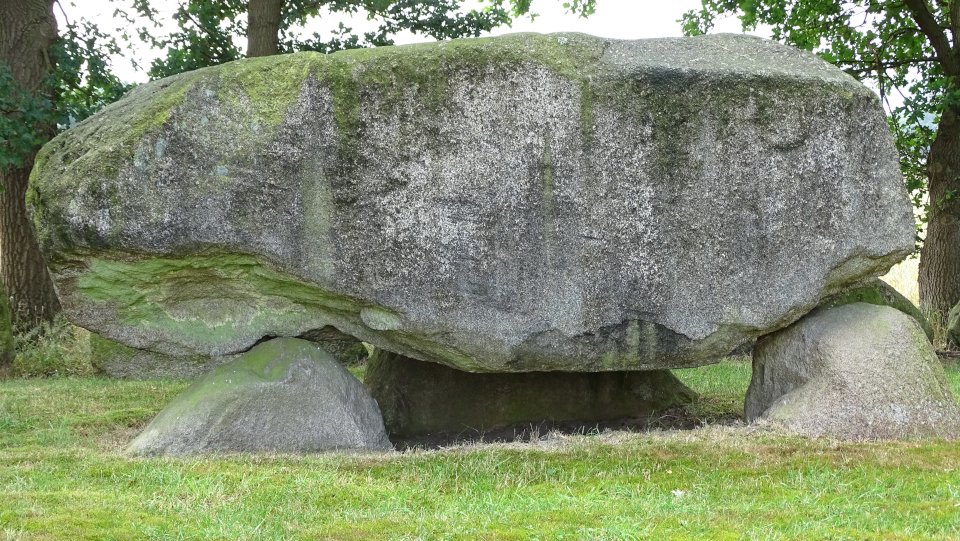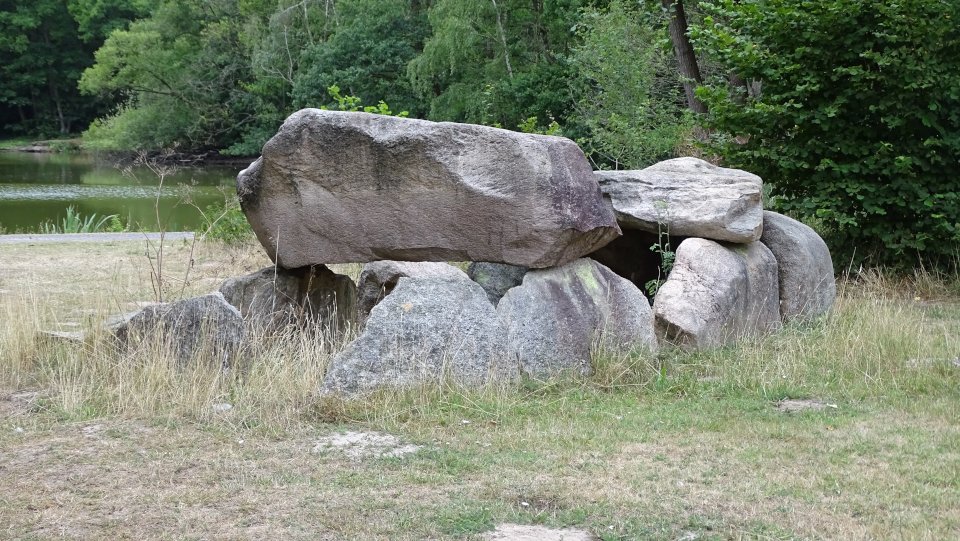





Original and current layout of the megalithic tomb
after Ernst Sprockhoff, Atlas of the German megalithic tombs
Visited July 2018
Dingstede, situated on the western boundary of the municipality of Ganderkesee, was first mentioned as “Thingenstede” in a document of the Hude Monastery from 1249. Accordingly, the origin of the place name Dingstede comes from at a court site (Thingstätte = thing site), which is often associated with a megalithic grave of the same name destroyed at the end of the 18th century. Whether the archaeological site was actually a court site is unclear. In any case, in 1973 a replica of just this thing site was built on the outskirts of Dingstede.
It is located west of Dingstede at the “Alter Postweg” road to Munderloh.
Visited July 2018






Hatten 2 aka “Steenberg” lies southeast of Sandhatten and is station 31 of the Straße der Megalithkultur so it is signposted and even has its own parking space. Drive from Sandhatten to Ostrittum and follow the signs, from the parking space it is a walk of about 700m around fields to the tomb, which lies under old oak trees.
The tomb is an approximately east-west oriented chamber of 16.3 x 2.0 meters dimension. Nearly all supporting stones are still present, only two are missing. Six capstones or parts of them are lying within the chamber. From the oval border some stones are still preserved.
Visited July 2018
taken from the “Faszination Archäologie” information board:
“Steenberg”
The approximately east-west oriented grave chamber has a relatively good state of preservation. Their supporting stones are almost completely extant, half even in their original position. Only on each long sides the loss of one stone is recorded. Also visible are six capstones plunged into the chamber or their remains. From the narrow oval enclosure, however, only fragments have survived.
Testimony of sedentary life
Megalithic tombs like “Steenberg” (stone hill) are considered the oldest surviving structures of northern Central Europe. Until the fourth millennium BC only hunters and gatherers lived in the Wildeshauser Geest. Only the “funnel beaker culture” (about 3500 – 2700 BC) settled down permanently.
They bred cattle, planted grain and lived in post constructions. Presumably, they believed in an otherworldly life and therefore built their deceased sometimes monumental graves of boulders. Those megalithic graves or megalithic tombs (Greek: mega = large, lithos = stone) were erected not for individuals, but for groups and used over many generations.









Only six scattered stones are all that remains from this megalithic tomb. It lies in the southwest of the village Sandhatten. If you drive from Huntlosen to Sandhatten turn left into the road Haferkampstraße and continue for about 150m, the tomb lies northeast of the road on a private field. According to Sprockhoff, the tomb was originally about 12m long.
Visited July 2018





Despite the fact the this megalithic tomb is signed from the road “Zum Döhler Wehe”, a visit is only recommended for the really enthusiastic (but I think there are some here on this website ;-) ) as the tomb is heavily destroyed and overgrown. You’ll find the tomb if you drive from Huntlosen on the K337 westward to Hengstlage. About 2.5km behind Huntlosen turn left into “Zum Döhler Wehe” drive for another 725m and park at N52° 59’ 01.8” E8° 14’ 30.3”. There is a track which leads roughly soutwest around a field, after 100m the track turn westwards and after additional 380m a tracks leads north into the wood (there is also a sign for the tomb). After 90m into the wood, the tomb lies to the right.
As I said, the tomb is heavily destroyed, only some of the supporting stones and a end stone survived, none of the capstones. Also the heavy vegetation prevents a clearer view of the site. According to the information baord the original size was about 14 x 2m. There are some grave mounds in this area as well.
Visited July 2018
taken from the “Faszination Archäologie” information board:
Neolithic tomb
The megalithic tomb was exposed early to human destruction. Today it is one of the less well-preserved Neolithic tombs of the Wildeshauser Geest. The remaining stones nevertheless give an idea of the original layout.
Testimony of sedentary life
Megalithic tombs are considered the oldest surviving structures of northern Central Europe. Until the fourth millennium BC only hunters and gatherers lived in the Wildeshauser Geest. Only the “funnel beaker culture” (about 3500 – 2700 BC) settled down permanently.
They bred cattle, planted grain and lived in post constructions. Presumably, they believed in an otherworldly life and therefore built their deceased sometimes monumental graves of boulders. Those megalithic graves or megalithic tombs (Greek: mega = large, lithos = stone) were erected not for individuals, but for groups and used over many generations.

View from the west to the east
Visited July 2018

View from the east to the west
Visited July 2018


original size of chamber: ~ 14 x 2m
above: reconstruction of original ground plan
below: current condition (after E. Sprockhoff 1975)
Visited July 2018
In the fall of 1984, large stones that disturbed plowing on a field near Düste were to be removed. It turned out that these were the remains of a megalithic grave, which were immediately examined by an official excavation. Unfortunately, the chamber had been ransacked earlier by grave robbers, but it still found remains of 60 clay pots, an arrowhead and a stone ax.
The tomb was then transferred to the northwest edge of Barnstorf to the Walsener ponds, whereby not only supporting and cover stones, but also the soil paving were restored. A shattered stone was replaced by a foreign stone, the original fragments are still next to the chamber. The chamber measures 5.2 x 1.5 m inside. Of the original four capstones only two are preserved.
Visited July 2018






Damme 3 lies about 4km north northeast of Damme in the forest Dammer Fuhrenkamp, south of Stappenberg. To reach the tomb, drive the road L846 from Damme to Steinfeld (Oldenburg). About 3.5km after Damme turn right in the Eichenallee and follow this road for about 1.2km, partly on a unpaved road.
The 32-meter-long chamber must once have been magnificent, today it is heavily destroyed and plundered. The stones are mixed up and you can identify seven capstones or the remains of them. A stone on the south side of the tomb has a noticeable row of drillholes.
Visited July 2018





Southwest of Damme in the Clemens-August-Dorf north of the L846 on both sides of the branching K277 (to Ossenbeck) two passage graves are located: Damme 1 and Damme 2. You can use the car park of the cemetery Kommunaler Friedhof Neuenwalde to visit both sites. To visit Damme 1 you must walk about 550m from the car park, Damme 2 lies actually within the cemetry.
Damme 2 is very poorly preserved and lies close to the entrance of the cemetry, probably the only megelithic tomb which is located within a cemetry. There are no signs or an information board which guides you to the tomb. You can still see some of the supporting stone and capstones and rests of the mound, but the overall structure or shape is hard to imagine. The tomb was according to Sprockhoff originally almost 30 meters long. Its remains are still 19 meters long and about 1.6 meters wide. The end stone to the west is present, the eastern missing.
Visited July 2018

